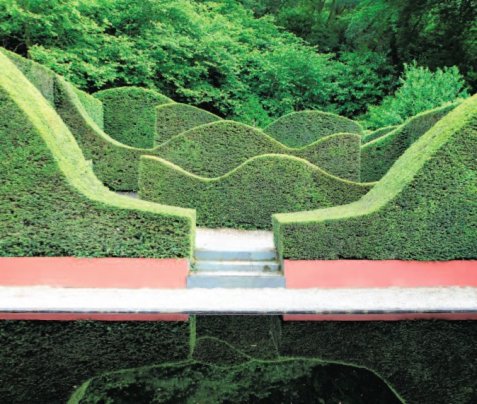Musings in our house have turned to the magical quality of water, to where to put it in the garden and what the influences and inspiration might be. I will walk you round the history and psychology of water in the landscape, but for starters, I am giving rosettes for my three favourites. 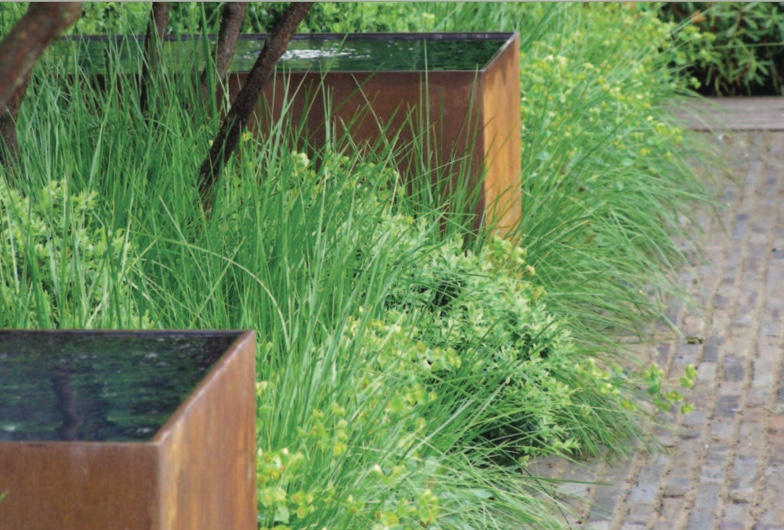 The first goes to Tom Stuart Smith for his understated and covetable weathering steel (Cor-ten) bowls shown in one of his Chelsea show gardens. Cor-ten has a stable rusty appearance and has become a fashionable hard landscaping material. He used the colour to show up interesting bare stems and a plethora of plants from a pale blue and white palette. The point about the bowls is that they were brimful, water held in a meniscus by surface tension. The surface wobbled like a jelly. I could look at this all day. Second rosette to Anne Wareham of “Bad Tempered Gardener” fame. Veddw, her garden in Wales, is carved out of a hill, has views out and rooms within curvaceous clipped hedges. The focal point at the centre, a rectangular reflecting pond, pared down in simplicity and throwing the view back at the surrounding trees. She keeps the water tinged with quantities of black ink.
The first goes to Tom Stuart Smith for his understated and covetable weathering steel (Cor-ten) bowls shown in one of his Chelsea show gardens. Cor-ten has a stable rusty appearance and has become a fashionable hard landscaping material. He used the colour to show up interesting bare stems and a plethora of plants from a pale blue and white palette. The point about the bowls is that they were brimful, water held in a meniscus by surface tension. The surface wobbled like a jelly. I could look at this all day. Second rosette to Anne Wareham of “Bad Tempered Gardener” fame. Veddw, her garden in Wales, is carved out of a hill, has views out and rooms within curvaceous clipped hedges. The focal point at the centre, a rectangular reflecting pond, pared down in simplicity and throwing the view back at the surrounding trees. She keeps the water tinged with quantities of black ink. 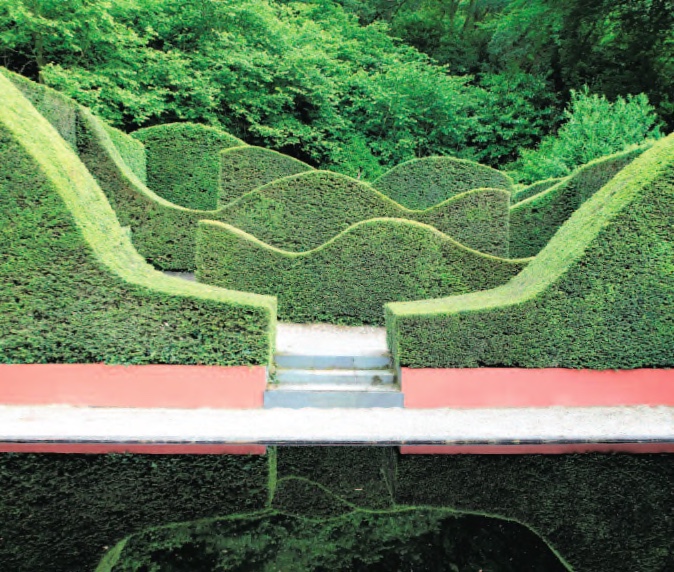 Third to local garden designer Amelia Singleton for this lovely composition of Schoenbrunn yellow walls with awesome lead planter. Again I think the allure is in the brimming bubbled appearance and the planting too, of course. This is the one I want here because it suits my old house and also, I have just spoken to Amelia and it is faux lead which will be less heavy to carry and pay for.
Third to local garden designer Amelia Singleton for this lovely composition of Schoenbrunn yellow walls with awesome lead planter. Again I think the allure is in the brimming bubbled appearance and the planting too, of course. This is the one I want here because it suits my old house and also, I have just spoken to Amelia and it is faux lead which will be less heavy to carry and pay for. 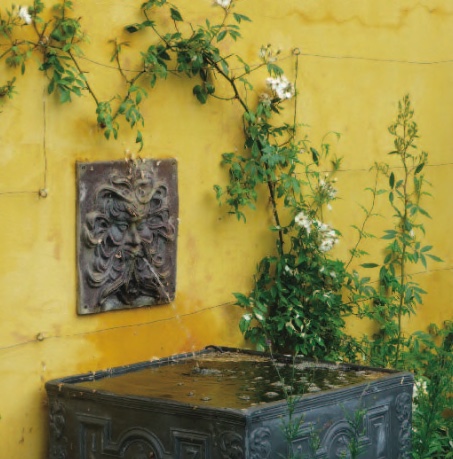 To history. The first great gardens were made by the Persians. From oases with date palms to the Mughul gardens of Kashmir all centred on water. The apogee of these early havens from a harsh climate is the Alhambra, Granada with its cloisters, pools and cooling arcs of water. This sublime Muslim garden, built in 1370 for the Nasrid rulers of Spain was un- eclipsed for 2 centuries. Then the wealth of Rome, kept in the family by ‘nephews’ of popes saw an outbreak of serious showing off on the horticultural front. Take Cardinal Ippolito D’este, son of Lucrezia Borgia and a bishop by the age of 10. Ippolito was made governor of Tivoli. He plundered Hadrian’s Villa in the valley below. Statues were relocated and fountains installed. The hydraulics were sensational : jets of water shot high into the air and a musical organ was powered by water. Other cardinals followed suit and pleasure gardens were built at Villas Lante and Farnese as summer retreats from the heat and smell of Rome. Both have staircases with water coursing down them. Villa Lante has a vast stone table with its centre hollowed out as a cool, wet well for the wine bottles.
To history. The first great gardens were made by the Persians. From oases with date palms to the Mughul gardens of Kashmir all centred on water. The apogee of these early havens from a harsh climate is the Alhambra, Granada with its cloisters, pools and cooling arcs of water. This sublime Muslim garden, built in 1370 for the Nasrid rulers of Spain was un- eclipsed for 2 centuries. Then the wealth of Rome, kept in the family by ‘nephews’ of popes saw an outbreak of serious showing off on the horticultural front. Take Cardinal Ippolito D’este, son of Lucrezia Borgia and a bishop by the age of 10. Ippolito was made governor of Tivoli. He plundered Hadrian’s Villa in the valley below. Statues were relocated and fountains installed. The hydraulics were sensational : jets of water shot high into the air and a musical organ was powered by water. Other cardinals followed suit and pleasure gardens were built at Villas Lante and Farnese as summer retreats from the heat and smell of Rome. Both have staircases with water coursing down them. Villa Lante has a vast stone table with its centre hollowed out as a cool, wet well for the wine bottles. 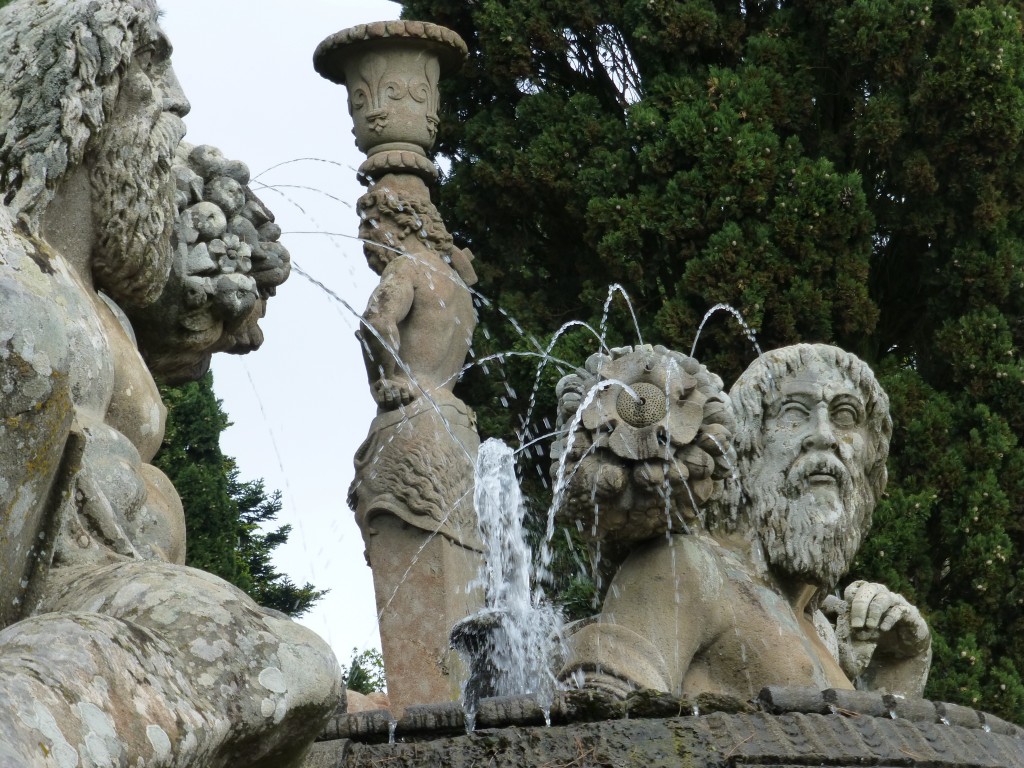 The making of sophisticated allegorical gardens and love affair with hydraulics was taken up by the French. The most famous example is Versailles, designed by Le Notre for Louis XIV. Alas the lack of gradient meant the gardeners had to sneak ahead of the king strolling in his gardens, turning on the taps as he processed. Greater success was to be had in England at Chatsworth where Le Notre’s pupil Grillet installed the Cascade of steps that riffled water down the hill, a musical tune given by the uneven surface of the submerged stone. The Cascade was installed in 1696, with further fine-tuning in 1703 and by now fashion was turning from the Baroque style to the natural landscape. This interpretation was perpetuated by Capability Brown. His lovely landscapes, a lake in every one to drain the marshy land round the house, have defined our countryside. Its interesting to remember that economics and jingoism shaped the designer’s mindset.
The making of sophisticated allegorical gardens and love affair with hydraulics was taken up by the French. The most famous example is Versailles, designed by Le Notre for Louis XIV. Alas the lack of gradient meant the gardeners had to sneak ahead of the king strolling in his gardens, turning on the taps as he processed. Greater success was to be had in England at Chatsworth where Le Notre’s pupil Grillet installed the Cascade of steps that riffled water down the hill, a musical tune given by the uneven surface of the submerged stone. The Cascade was installed in 1696, with further fine-tuning in 1703 and by now fashion was turning from the Baroque style to the natural landscape. This interpretation was perpetuated by Capability Brown. His lovely landscapes, a lake in every one to drain the marshy land round the house, have defined our countryside. Its interesting to remember that economics and jingoism shaped the designer’s mindset.  Fast forward time to New York and Ground Zero. It is an extraordinary memorial ground, designed by Daniel Libeskind. Both towers have been excavated out on the original footprint, an inner square in each appears to go down to base rock. Water cascades down the sides, masking the noise of traffic, sending up beads that weep on the copper rail, engraved with the names of the dead. In autumn, leaves float off surrounding trees and get whipped down into the void. For the use of water you will never see anything so mesmeric and poignant as this. Nothing to do with gardens, I know, but a reminder of the potency and psychological impact of this raw element. This article first appeared in Essential Suffolk Magazine
Fast forward time to New York and Ground Zero. It is an extraordinary memorial ground, designed by Daniel Libeskind. Both towers have been excavated out on the original footprint, an inner square in each appears to go down to base rock. Water cascades down the sides, masking the noise of traffic, sending up beads that weep on the copper rail, engraved with the names of the dead. In autumn, leaves float off surrounding trees and get whipped down into the void. For the use of water you will never see anything so mesmeric and poignant as this. Nothing to do with gardens, I know, but a reminder of the potency and psychological impact of this raw element. This article first appeared in Essential Suffolk Magazine
